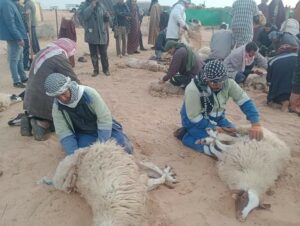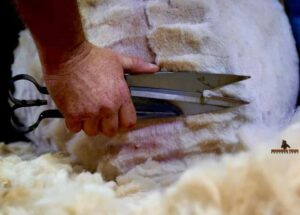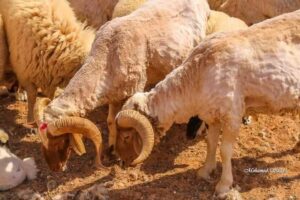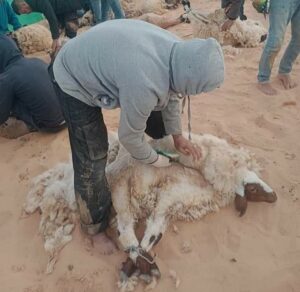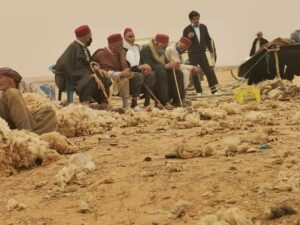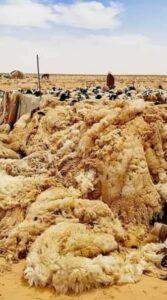In the desert in southern Tunisia, dozens of hair tents are erected by sheep owners and shepherds from the beginning of April until mid-June. This is the period when sheep continue to be sheared in order to reduce the weight of the wool .before the heat rises
Shearing is the process of shearing and thinning sheep’s wool as much as possible, before the temperatures rise, so that they do not weaken or get sick, and so that they can grow more and stay safe from the high heat
Shearing is the process of cutting and thinning the sheep’s wool as much as possible, before the temperatures rise, so that they don’t weaken or get sick, and so that they can grow more and stay safe from the high heat. It is an annual process that takes place during this period every year
Tataouine’s sheep owners agree on a specific time to meet at a remote location in the desert to set up the tents and prepare everything necessary for the shearing process. This is not just a passing event, but an annual celebration that the people of Tataouine celebrate in their own way. The process of shearing sheep is found in all rural areas and states, and most of it is done in a normal way. Every farmer shears his own sheep in his barn However, the people of Tataouine have their own customs for this event. They celebrate it in the form of a festival or a desert carnival All the people of these areas participate in it (the Shearing Festival in Samar),
Men and women prepare for the occasion, “The process begins with the selection of a suitable place to set up tents from the beginning of April, and the men basically head with their equipment, tents, and stakes to the agreed upon location. The process of erecting these tents lasts for about three days. Old tents, like those found in some deserts in southern Tunisia, are made of camel and goat hair to protect them from the heat of the sun and strong winds
“After that, the women go to the place to spread the ground under the tents, carrying some utensils and enough food to last them for the days of shearing. Before this process begins, drums are beaten and songs are sung in preparation for this popular event, which has been handed down for decades in these areas.”
The women prepare food for the men, while the shearing process begins by choosing who has the largest herd, and the process is more like a competition between the men, about who can shear the largest number
According to tradition, “every sheep owner has to slaughter some of his sheep to prepare feasts for all the participants in the event The women prepare food for the men, while the shearing process begins with a farmer’s sheep Whoever has the largest herd is chosen to start the shearing process. The roles are divided between those who lead the herd and those who tie them to the ground. The process may be more like a competition between the men, to compete among themselves, about who will shear the largest number of the herd, to be the ‘shatir’ among them.”
This is an ancient Bedouin ritual that has been handed down by many clans in Tataouine, and remains a custom that is mainly celebrated by the Bedouin people. Even residents of villages and cities near the desert have not dispensed with this event, which is held in different ways from one region to another, but they share the celebratory character and folklore, which also varies according to the customs of each region
In Tataouine province, people living near the desert also travel to the desert during this season and set up tents. But no women accompany them. Only the men travel to the valleys where they used to graze They choose a place after agreeing on it, and carry simple supplies: Some greens and oil, and some pots for them to cook themselves
After the tents are set up, they gather on the eve of the festival to light a fire and offer each other’s generosity to those present. The meat is grilled on firewood, or cooked in a large pot and distributed to each other They spend the night talking to each other Sometimes their voices echo in the desert with Bedouin songs or desert poems that they have memorized from generation to generation.”
The next day, the shearing process begins at 4 a.m They start the day with tea, goat’s milk and some bread. They live those days in a very primitive way.
The team is divided between those who bind the sheep and tie their legs, those who sharpen the shearing scissors called “jalam”, and those who choose to do the shearing. The process continues for days, until the entire herd is sheared
Many herd owners pay those who have practiced sheep shearing in the desert, “and the process takes place in a special atmosphere in these regions, unlike the northern regions, and sometimes some women participate in this seasonal event.”
This event, which is repeated annually at the same time, continues to provide seasonal jobs and creates a movement in Tataouine by reviving a popular festival that is welcomed by desert dwellers, farmers, and herd owners
Badia people there say that the wool is collected to be delivered to women who are proficient in making and spinning wool to make carpets or “marqoum” and “kelim,” despite the decline in the number of craftswomen in those areas. It is also delivered to some wool collectors to be used in several industries, especially textiles. Large quantities of wool go to waste due to the lack of textile processing units in the interior regions.
